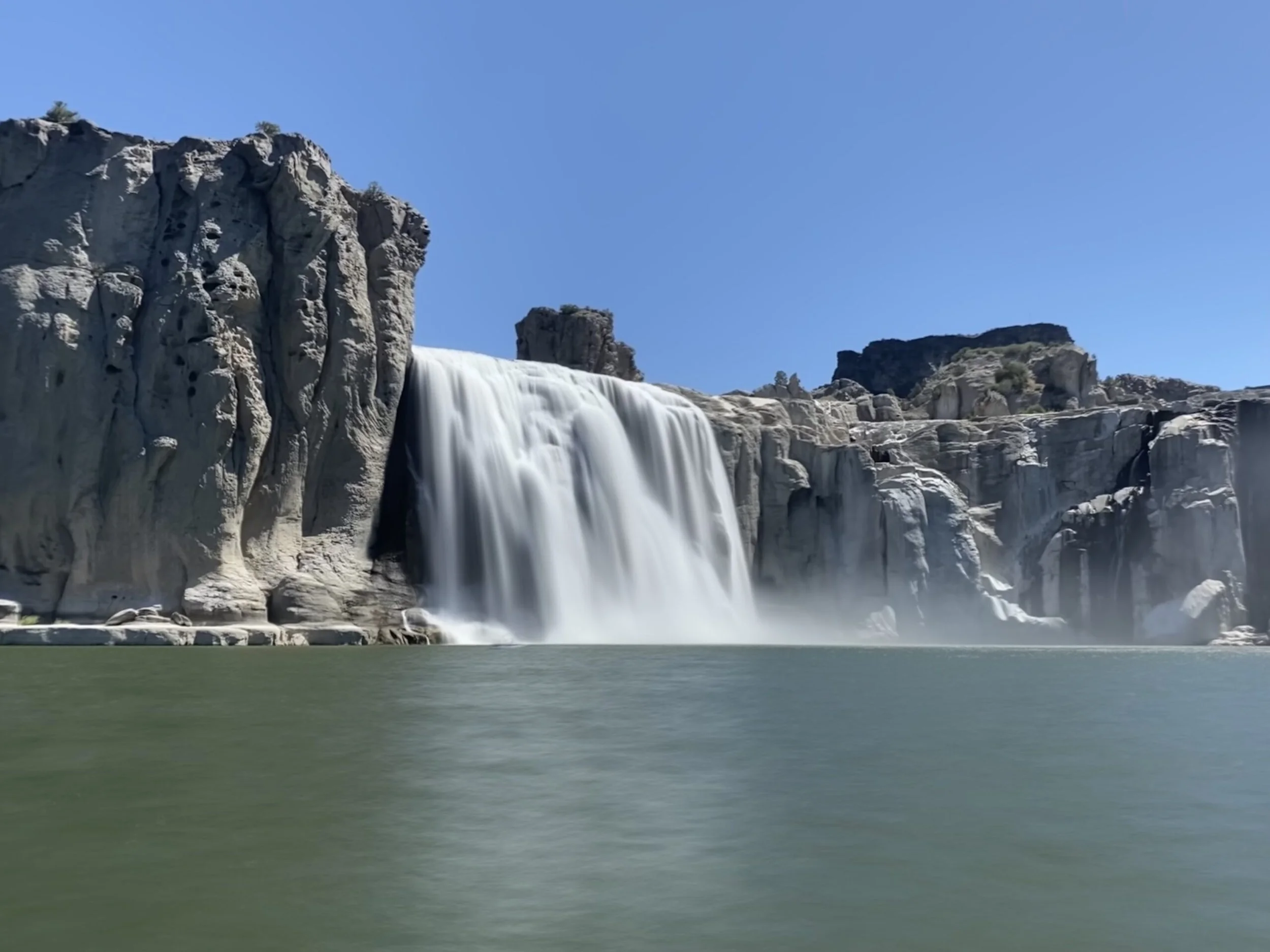Beat the heat: What to know about kayaking to Pillar and Shoshone Falls
Just as Idaho’s wildflower-filled hills provide us joy in the spring, and sheltering valleys provide us refuge in the winter, the Gem State’s rivers, lakes, and streams provide us oases in the summer. As temperatures rise and the sun beats down, Idahoans across the state look to the water to cool off. In southern Idaho, the Snake River is one of the most popular places to beat the heat.From floating to paddling to boating, there are plenty of water activities to enjoy on the Snake. Hungry for both adventure and great panoramic views of the canyon, Idaho Conservation League staff recently headed to Twin Falls for a kayaking excursion.The early morning drive from Boise to Twin Falls was serene. Sagebrush speckled the landscape. Pronghorn roamed in the distance before the heat set in. Hawks perched still on power lines along the road, awaiting their next meal. We were excited to reach our destination and get out on the water.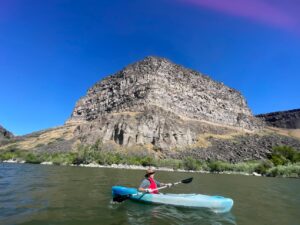 Our adventure began at Centennial Waterfront Park, which is located on the north side of the canyon. We packed up our sunscreen, lunches, and plenty of water before heading down to the AWOL Adventure Sports for the rest of our gear. The locally-owned rental business set us up with kayaks, paddles, and life jackets, and even helped us launch from the dock onto the water – making for an easy start to our outing.We planned to kayak two miles to Pillar Falls and then another two miles to Shoshone Falls, if time allowed. As we started paddling, we took time to look up at the basalt towering around us and spot wildlife that call the region home. Two of my coworkers spotted a sturgeon as it rolled on the surface, showcasing its prehistoric form, spiny back and long snout. Meanwhile, another coworker and I sat mesmerized by the hues of black and gray rock swirling around us, stretching out as far as the eye could see.
Our adventure began at Centennial Waterfront Park, which is located on the north side of the canyon. We packed up our sunscreen, lunches, and plenty of water before heading down to the AWOL Adventure Sports for the rest of our gear. The locally-owned rental business set us up with kayaks, paddles, and life jackets, and even helped us launch from the dock onto the water – making for an easy start to our outing.We planned to kayak two miles to Pillar Falls and then another two miles to Shoshone Falls, if time allowed. As we started paddling, we took time to look up at the basalt towering around us and spot wildlife that call the region home. Two of my coworkers spotted a sturgeon as it rolled on the surface, showcasing its prehistoric form, spiny back and long snout. Meanwhile, another coworker and I sat mesmerized by the hues of black and gray rock swirling around us, stretching out as far as the eye could see.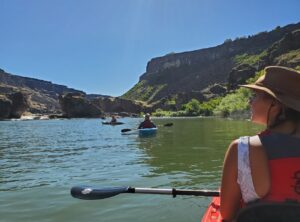 On the way to Pillar Falls, we paddled under Perrine Bridge, where you will likely see BASE jumpers tumbling into the air above you during the summer. While the bridge (and those brave enough to BASE jump off of it) surely looked impressive from the water below, nothing compared to the area’s natural infrastructure.The landscape of this region was created by volcanic activity followed by one of the largest floods in geological history. Eruptions and lava flows deposited igneous rocks such as basalt and rhyolite roughly two million years ago. Then, nearly 14,500 years ago, the Bonneville Flood carved out the path of the Snake River as it flows today, fully assembling the landscape.As we paddled beneath the bridge and around the bend, Pillar Falls came into view – greeting us with several rhyolite pillars climbing into the sky and a series of waterfalls rushing below. Rhyolite rock, which is a volcanic rock, is usually pink or gray in color – adding contrast to the dark-colored basalt.
On the way to Pillar Falls, we paddled under Perrine Bridge, where you will likely see BASE jumpers tumbling into the air above you during the summer. While the bridge (and those brave enough to BASE jump off of it) surely looked impressive from the water below, nothing compared to the area’s natural infrastructure.The landscape of this region was created by volcanic activity followed by one of the largest floods in geological history. Eruptions and lava flows deposited igneous rocks such as basalt and rhyolite roughly two million years ago. Then, nearly 14,500 years ago, the Bonneville Flood carved out the path of the Snake River as it flows today, fully assembling the landscape.As we paddled beneath the bridge and around the bend, Pillar Falls came into view – greeting us with several rhyolite pillars climbing into the sky and a series of waterfalls rushing below. Rhyolite rock, which is a volcanic rock, is usually pink or gray in color – adding contrast to the dark-colored basalt. During the summer, lower water levels allow you to explore the area around Pillar Falls, which we took full advantage of. We pulled our kayaks onto the right hand side of the pillars, where you can safely climb out. We explored rock formations and pools of many shapes and sizes before deciding what to do next – start the journey back, or continue up the river to Shoshone Falls. Hungry for more, we chose the latter. We teamed up to carry our kayaks over the rocky area. After several pit stops to let our hands and arms recover, we reached the other side of Pillar Falls, put our kayaks back in the water, and began the next 2-mile stretch to Shoshone Falls.
During the summer, lower water levels allow you to explore the area around Pillar Falls, which we took full advantage of. We pulled our kayaks onto the right hand side of the pillars, where you can safely climb out. We explored rock formations and pools of many shapes and sizes before deciding what to do next – start the journey back, or continue up the river to Shoshone Falls. Hungry for more, we chose the latter. We teamed up to carry our kayaks over the rocky area. After several pit stops to let our hands and arms recover, we reached the other side of Pillar Falls, put our kayaks back in the water, and began the next 2-mile stretch to Shoshone Falls. 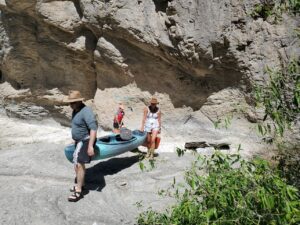 The extra 2-mile journey to Shoshone Falls was worth every paddle. Not only are the views incredible, but the mist from the falls blasts across the water – refreshing recreationists from a safe distance. Shoshone Falls is located at another rhyolite flow in the canyon. Since rhyolite tends to be more resistant to erosion than basalt, it is a natural place for a barrier like a waterfall to form.After taking in the beauty of the falls, we started the 4-mile journey back. This time, we were going with the current, but against the wind. Even though the water is relatively flat, winds can pick up at any time of day and in any direction, making for a challenging paddle. The lackadaisical journey upstream was replaced by an upper body workout on the way back – something to keep in mind when planning your outing. Being prepared is key to staying safe on your adventure.
The extra 2-mile journey to Shoshone Falls was worth every paddle. Not only are the views incredible, but the mist from the falls blasts across the water – refreshing recreationists from a safe distance. Shoshone Falls is located at another rhyolite flow in the canyon. Since rhyolite tends to be more resistant to erosion than basalt, it is a natural place for a barrier like a waterfall to form.After taking in the beauty of the falls, we started the 4-mile journey back. This time, we were going with the current, but against the wind. Even though the water is relatively flat, winds can pick up at any time of day and in any direction, making for a challenging paddle. The lackadaisical journey upstream was replaced by an upper body workout on the way back – something to keep in mind when planning your outing. Being prepared is key to staying safe on your adventure.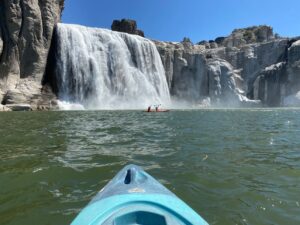 Another key part of staying safe – wearing a life jacket. Idaho Code requires all children under 15 to wear a life jacket when on any watercraft and when in the water. Also, regardless of age, all people using kayaks, paddle boards, rafts, and all other watercraft must have a life jacket on board at all times. We saw two paddle boarders get ticketed for not following the rules.From keeping yourself safe to keeping the river safe, it’s also important to recreate responsibly on and around the water. Come prepared with the proper gear and enough sunscreen, food, and water, and let someone know where you’re going. Try to leave the landscape better than you found it, making sure you pack out what you pack in and picking up any pieces of trash you may come across. It’s up to all of us to ensure these places remain clean for the next visitors, and the next generation.
Another key part of staying safe – wearing a life jacket. Idaho Code requires all children under 15 to wear a life jacket when on any watercraft and when in the water. Also, regardless of age, all people using kayaks, paddle boards, rafts, and all other watercraft must have a life jacket on board at all times. We saw two paddle boarders get ticketed for not following the rules.From keeping yourself safe to keeping the river safe, it’s also important to recreate responsibly on and around the water. Come prepared with the proper gear and enough sunscreen, food, and water, and let someone know where you’re going. Try to leave the landscape better than you found it, making sure you pack out what you pack in and picking up any pieces of trash you may come across. It’s up to all of us to ensure these places remain clean for the next visitors, and the next generation. As Idaho continues to grow, responsible recreation is increasingly important – especially for places along the Snake River in southern Idaho, which already face a slew of threats. Overallocation of the water and pollution from industries, farms and cities have made some areas of the Snake unsafe to even touch or eat fish from. But it doesn’t have to be this way.ICL is working to restore the Snake River as it flows through southern Idaho to safe, swimmable, and fishable conditions. You can help protect places like Shoshone and Pillar Falls by taking action below to voice your concerns regarding the health of the Snake to our elected officials. Together, we can protect and restore the Snake River for now and future generations.
As Idaho continues to grow, responsible recreation is increasingly important – especially for places along the Snake River in southern Idaho, which already face a slew of threats. Overallocation of the water and pollution from industries, farms and cities have made some areas of the Snake unsafe to even touch or eat fish from. But it doesn’t have to be this way.ICL is working to restore the Snake River as it flows through southern Idaho to safe, swimmable, and fishable conditions. You can help protect places like Shoshone and Pillar Falls by taking action below to voice your concerns regarding the health of the Snake to our elected officials. Together, we can protect and restore the Snake River for now and future generations.

